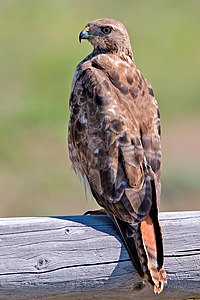
Photo from wikipedia
Abstract Standard occupancy models enable unbiased estimation of occupancy by accounting for observation errors such as missed detections (false negatives) and, less commonly, incorrect detections (false positives). Occupancy models are… Click to show full abstract
Abstract Standard occupancy models enable unbiased estimation of occupancy by accounting for observation errors such as missed detections (false negatives) and, less commonly, incorrect detections (false positives). Occupancy models are fitted to data from repeated site visits in which surveyors record evidence of species presence. Use of indirect sign (e.g., scat, tracks) as evidence of presence can vastly improve survey efficiency for inconspicuous species but can also introduce additional sources of error. We developed a “multi‐sign” occupancy approach to model the detection process separately for unique sign types and used this method to improve estimates of occupancy dynamics for an inconspicuous species, the American pika (Ochotona princeps). We investigated how estimates of pika occupancy and environmental drivers differed under four increasingly realistic representations of the observation process: (1) perfect detection (commonly assumed for modeling pika occupancy), (2) standard occupancy model (single observation process without possibility of false detection), (3) multi‐sign with no false detections (non‐false positive model), and (4) multi‐sign with false detections (full model). For the multi‐sign occupancy models, we modeled the detection of each sign type (fresh scat, fresh haypiles, pika calls, and pika sightings) separately as a function of climatic and environmental covariates. Estimates of occupancy processes and inferences about environmental drivers were sensitive to different detection models. Simplified representations of the detection processes generally resulted in higher occupancy estimates and higher turnover rates than the full multi‐sign model. Environmental drivers also varied in their influence on occupancy models, where (e.g.) forb cover was estimated to more strongly influence occupancy in the full multi‐sign model than the simpler models. As has been reported previously in other contexts, unmodeled heterogeneity in the observation process can lead to biases in occupancy processes and uncertainty in the relationships between occupancy and environmental covariates. Overall, our multi‐sign approach to dynamic occupancy modeling, which accounts for spatio‐temporal variation in reliability among sign types, has strong potential to generate more realistic estimates of occupancy dynamics for inconspicuous species.
Journal Title: Ecology and Evolution
Year Published: 2023
Link to full text (if available)
Share on Social Media: Sign Up to like & get
recommendations!